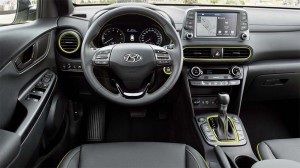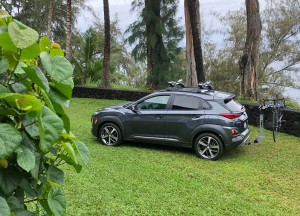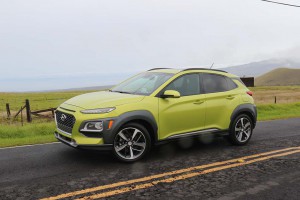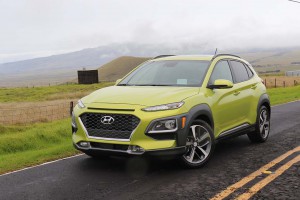So much for palm trees swaying in a sunny, South Pacific breeze. The wind is blowing, all right, but the normally desert-like Kona Coast is anything but warm and dry as we head out for a day’s drive across the Big Island of Hawaii.
Actually, we’re just fine with that, as it gives us a chance to put the new 2019 Hyundai Kona through its paces as we explore one of the most ecologically diverse places on the planet. By the time we wrap up we’ll experience just about every sort of weather one can imagine short of snow – and at the top of Saddle Road, which cuts between the currently dormant Mauna Kea and Mauna Loa volcanoes, even a blizzard is possible.
We’ve spent nearly 12 hours in the air flying to, yes, Kona, Hawaii to see just how well the new Kona crossover lives up our expectations. Hyundai was slow to recognize one of the most dramatic shifts in the automotive market, the rapid shift from sedans and coupes to SUVs and crossover-utility vehicles. As it rolls into dealer showrooms across the U.S. in the coming weeks, it becomes the Korean brand’s third utility vehicle, joining the compact Tucson and midsize Santa Fe – with an assortment of others, including the hydrogen-powered Nexo, to follow.
(Click Here for a review of the new Hyundai Nexo fuel-cell vehicle.)
The Kona will be the smallest member of the brand’s rapidly expanding crossover line-up. And it will target a subcompact segment that is rapidly growing, sales up 4% last year despite the overall decline of the American new vehicle market. By some estimates, demand could outstrip larger CUV segments in the coming years.
That said, Hyundai will be facing a lot of competition. According to a study by consulting firm AutoPacific Inc., there are already 38 crossovers with wheelbases of less than 110-inches – thought that figure straddles the compact and subcompact segments. They cover every price class, including luxury models like the BMW X1 and the newly launched Lexus UX, though Kona more directly targets mainstream models like the Ford EcoSport, Honda HR-V and Subaru Crosstrek.
Kona is a full foot shorter than the Hyundai Tucson. It’s also one of the smallest vehicles in its class, at least if you’re looking at its outside dimensions. At 164.0 inches it’s a full 11 inches shorter than the Subaru and 9.1 inches shorter than the Honda. The one dimension where it stands out is width, having a one-inch advantage over the HR-V.
But such numbers can be misleading, as you quickly discover while loading four onboard, along with a cargo bay full of goodies. The two-level storage system yields 19.2 cubic feet of space, third largest in the segment. And there’s a useful bit of hidden space beneath the rear load floor that’s good for hiding a purse, computer bag or other valuables.
Visually, the 2018 Hyundai Kona is one of the most attractive models in its segment. Design chief Chris Chapman and his team fretted excessively over the CUV’s proportions, a challenging task for something this small. Yet, with its coupe-like roofline and rising accent line running through its doors, Kona boasts a surprisingly nice balance compared to more awkward alternatives like the Jeep Renegade.
Intriguingly, the design team picked up on a styling detail that we first saw on the larger Jeep Cherokee when it returned to the market a few years ago. The front lamps are split between three levels, with LED running lights and turn signals mounted immediately below the hood and wrapping into the front fenders. The headlamps frame the big chain mail grille. And fog lamps nestle under the front bumper.
If there’s one weak element, to our eyes, it’s what Hyundai calls the Pro-Tec-T. We call it cladding, and while it does give the Kona a bit more of a rugged look, it’s a bit too much of a cliché.
(Hyundai’s Le Fil Rouge concept pushes the design boundaries at Geneva. Click Here to check it out.)
The theme of the design, explained Chapman, was to “create a car for urbans adventurers and the lifestyle they lead.” At first blush, that might translate into Millennials on a budget and “price popus up as being (very) important” to buyers in this segment, chimes in Mike O’Brien, the vice president of corporate planning for Hyundai Motor America.
But while some models – think of the aforementioned Renegade – unabashedly aim to appeal, first and foremost on price, Hyundai also recognized that there are plenty of older, more affluent buyers who want what it described as a “weekend freedom vehicle.” In many cases, CUV buyers drop down a segment from the sedans they’re trading in. So a midsize or compact buyers might be just fine with a crossover the size of the Kona.
And that’s led Hyundai to offer an unexpectedly diverse set of choices, including not only front and all-wheel-drive but a pair of four-cylinder engines. Toss in some upscale details like leather seats and a range of high-tech safety and infotainment technology and it’s attempting to cover a wide range of buyers.
We spent most of our time driving a tropical line-colored Kona equipped with the more sporty 1.6-liter turbo engine. Paired with a seven-speed dual-clutch transmission, it punches out 175 horsepower and 195 pound-feet of torque. More importantly, that power comes on at extremely low revs and shows little drop-off even as we race up Saddle Road, climbing to a peak of 6,765 feet between Mauna Kea and Mauna Loa.
The engine barely breaks a sweat, even as we execute a high-speed pass as we head uphill, and the all-wheel-drive system retains its surefootedness despite the increasing rain as we crest the scenic route and descend towards Hilo on the always-rainy side of the island.
The all-wheel-drive model offers an additional advantage, a multi-link rear suspension rather than the live axle alternative on the front-driver. The benefits are readily apparent as we maneuver the roller-coaster-like whoop-de-dos of the Old Saddle Road and, later in the day, the steep and windy Hawaii 250. It’s the sort of suspension that can make these roads all the more fun to drive. Both versions feature a MacPherson front suspension, as well as brake-based torque vectoring, though the AWD model modulates both front and rear wheels.
The alternative engine package is a 2.0-liter Atkinson Cycle inline-four paired with a six-speed automatic. It makes an acceptable, albeit less than enthusiastic 147 hp and 132 lb-ft of torque. Curiously, both engines manage to deliver an EPA-estimated 30 mpg in front-drive configuration. The naturally aspirated package, especially in front-wheel-drive, is simply there for Millennials on a budget.
(A third powertrain package will be making its debut at the 2018 New York Auto Show: an all-electric version that, Hyundai insiders promise, will deliver something in excess of 200 miles of range.)
Whichever version you might opt for, the interior of the new 2019 Hyundai Kona is, like the exterior, far more stylish than you might expect considering the price tag. On premium models you add features like contrast stitching and leather, and an eight-inch navigation system. But even base models get a seven-inch display audio system, a backup camera, LED running lights, cruise control, auto-dimming headlamps and Bluetooth telephone.
Add into the standard equipment the Hyundai Smart Sense advanced driver assistance system, a package of technologies that, not all that long ago would’ve added thousands to the price of a small CUV like Kona. Among its features: Forward Collision Warning with Pedestrian Detection and Brake Assist, Lane Keeping Assistance, Rear Cross-Traffic Alert and Blind Spot Monitoring.
The one odd surprise is the lack of Active Cruise Control which can monitor traffic ahead and automatically adjust the vehicle’s speed to keep a safe pace. While not discussing specific reasons, Hyundai officials hint there were some issues getting the software just right, as they note all the necessary radar and camera sensors are already built in. Expect to see ACC added in the near future and it is possible – though not locked down – that earlier owners may be able to get their vehicles upgraded.
One other useful feature is a Head-Up Display system. Unlike most HUD packages that project their images on the windshield, Kona’s uses a clear plastic screen mounted atop the instrument panel, an approach shared with Mazda. One advantage is that if the windshield ever needs replacing it is far less expensive this way.
(NHTSA opens probe into Hyundai/Kia airbag issues. Click Here for more.)
When it comes to high-tech systems, Hyundai has recognized that the millennials who likely will make up a large share of Kona buyers have high expectations, even when they’re on a budget. The little CUV comes with a three-year complimentary subscription to Hyundai’s BlueLink telematics system and it can pair up with both Amazon’s Alexa and the Google Home voice assistants, while also pairing with Apple and Android smartwatches.
As for pricing, Hyundai is no longer determined to deliver the lowest-cost price of entry. Again, that’s where the Renegade comes in. But, at a base MSRP of $19,500 – plus $985 in delivery fees – it is on the low end of the subcompact CUV spectrum. A well-equipped Kona Ultimate package, with both the turbo engine and all-wheel-drive, comes in at $27,400.
For the money, Hyundai has come up with a small crossover that is clearly worth considering. It may have been late to the party, but it is clearly arriving in style.







